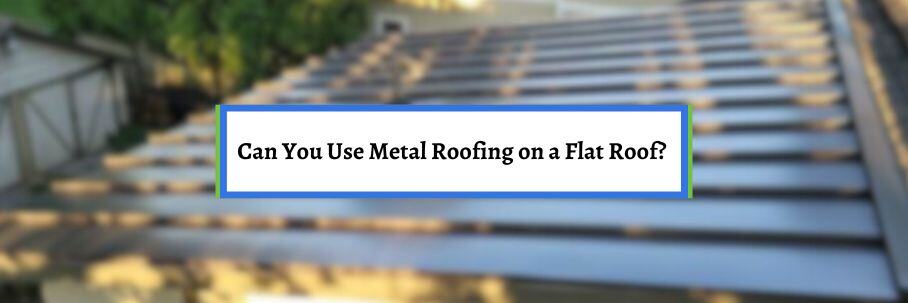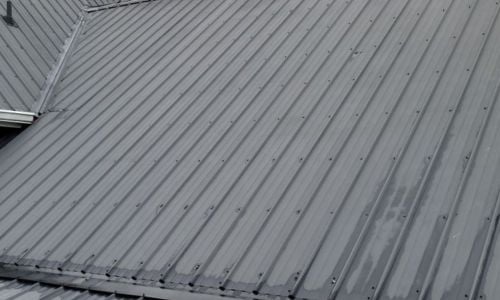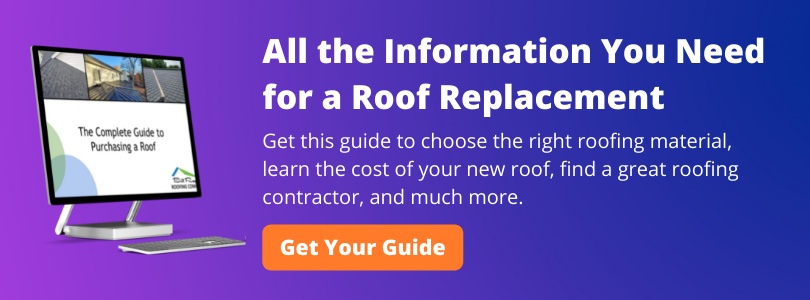Can You Use Metal Roofing on a Flat Roof?

Metal roofing is the fastest-growing material in the residential roofing industry. While there are plenty of reasons for this, versatility is a big driving force behind its popularity.
Metal roofing can be used in many places, but the roof pitch has to be right. This begs the question, “Can I use metal roofing on my flat roof?”
For over 30 years, Bill Ragan Roofing has helped homeowners understand the dos and don’ts of residential roof replacements. That’s why I’ll break down if you can and should use metal roofing on a flat roof.
This article answers the following questions:
- Should metal roofing be installed on a completely flat roof?
- Can you use metal roofing on a flat roof?
- Which type of metal roof system is best for a flat roof?
- How much will it cost to install a metal roof on a flat roof?
Should metal roofing be installed on a completely flat roof?
Metal roofing is a great option for low-slope roofs, but it should not be installed on a completely flat roof. This is per Section R905.10.2 of the 2021 International Residential Code which states that a roof must have at least a .25/12 to 3/12 roof pitch (depending on the metal roof type) for metal roofing.
According to the code, minimum slopes for residential metal roofing must comply with the following:
- The minimum slope for lapped, nonsoldered-seam metal roofs without applied lap sealant shall be 3 units vertical in 12 units horizontal (25-percent slope).
- The minimum slope for lapped, nonsoldered-seam metal roofs with applied lap sealant shall be 1/2 unit vertical in 12 units horizontal (4-percent slope). Lap sealants shall be applied in accordance with the approved manufacturer’s installation instructions.
- The minimum slope for standing-seam roof systems shall be 1/4 unit vertical in 12 units horizontal (2-percent slope).
This means a standing seam metal roof (seamed mechanically or by hand) can be installed on any roof over a .25/12 pitch (I recommend a .5/12 to be safe). It isn’t much slope, but it’s enough to avoid pooling water.
On the other hand, snaplock standing seam panels (snaps on instead of seamed) and exposed fastener metal roofs require a minimum roof pitch of at least a 3/12 (even if you apply a lap sealant). While it can’t be installed on a completely flat area, all hope isn’t lost if you really want a metal roof.
Can you use metal roofing on a flat roof?
You can still use metal roofing on a flat roof, but you'll have to add more slope with a built-up roof system. A built up roof (also called a tapered roof system) is created by adding layers of tapered insulation boards to “build” a steeper pitch.

These boards vary in thickness, so they can be stacked on each other and arranged until the desired angle is consistent across the roof. After the insulation boards are layered and fastened to the decking, your metal roof can be installed on the (previously) flat roof.
Unfortunately, this does add a big increase to labor and material prices. However, the insulation boards also help with energy efficiency, prevent condensation build-up, and reduce sound caused by rain.
Which type of metal roof system is best for a flat roof?
If you get a metal roof over a low slope or flat roof, it won’t shed water as much as steeper roof pitches. So, using a metal roof system that can handle reduced drainage is crucial.
Exposed fastener and standing seam roof systems both have their place in residential roofing, but standing seam is the best choice for a flat roof. A standing seam metal roof (also called hidden fastener) is locked together at the seams with clips or seamed mechanically.

The hidden fasteners make standing seam the best choice for flat roofing because there’s nothing coming through the panels (except for pipes and other penetrations) for water to follow inside. On the other hand, an exposed fastener metal roof (also called screw-down panel) has screws that attach directly to the roof decking through the metal.

This leads to periodically replacing the screws when they get wallowed out from the pressure of the panels not being able to expand and contract. Leaks are more likely with the fasteners (screws) exposed to the elements, which isn’t great for a low slope or flat roofs.
-2.png?width=500&height=409&name=ScrewDownMetalScrewsWallowed%20(2)-2.png)
Obviously, the decision is yours to make. However, I always recommend standing seam for residential purposes or anything else over a heated living space.
How much will it cost to install a metal roof on a flat or low slope roof?
While metal roofing’s popularity in residential roofing continues to grow, cost is the one thing holding it back. There are plenty of cost factors (including), but it mainly depends on the metal roof system.

For labor and materials, a new steel standing seam metal roof costs around $16.00 per square foot. As I said, this is the recommended type for a flat roof and residential roofing in general.

On the other hand, an exposed fastener metal roof is much cheaper at $4.50 to $6.50 per square foot. Just keep in mind that it’s prone to leaks, and you'll have to pay for consistent maintenance.
Also, remember that the price increases if you have to add a built up roof system to meet the minimum pitch requirements.
What are your other flat roofing options?
After reading this article, you know metal roofing shouldn’t be installed on a completely flat roof. However, you can still use it on a flat roof by adding the required pitch with a built up roof system.
Unfortunately, the cost and time required to do this are a big pain point for most homeowners. Luckily, metal roofing isn’t the only low-slope or flat roofing option.
In fact, there are materials specifically designed for flat roofing and waterproofing areas that don’t drain normally. So, before making a final decision, you need to know how metal roofing compares to the other top options.
Check out The 4 Best Materials for a Flat Roof (& How Much They Cost) to find the right flat roofing material for you.


